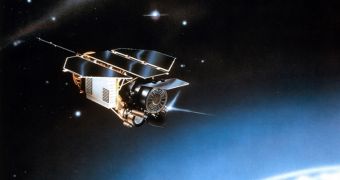The German Roentgen Satellite (ROSAT) X-ray space observatory will reenter Earth's atmosphere in November, mission managers at the German Aerospace Center (DLR) announced. They say that the machine has long-since reached the end of its life cycle, and that it's time for it to retire.
People are very weary of such news now, considering that the NASA Upper Atmosphere Research Satellite (UARS) gave many a scare recently. The American spacecraft reentered the atmosphere chaotically and out-of-control. It finally crashed in the Pacific Ocean without causing damages.
ROSAT mission managers say that it's still too early to tell where the telescope will crash after being decommissioned. They say that the chances of it hitting populated targets are extremely slim. In upcoming weeks, experts will refine the observatory's probable trajectory.
The swath of land debris from the satellite could cover stretches from Canada to South America, since the vehicle is inserted in an orbit that takes if from 53 degrees north to 53 degree south latitudes. Unlike the 6.5-ton UARS, this satellite tips the scales at just 2.4 ton, Space reports.
DLR officials say that about 1.6 tons of debris will eventually make their way into the atmosphere after surviving the scorching temperatures of atmospheric reentry. A total of about 30 large pieces will impact the ground or the ocean over the designated impact area.
“It is not possible to accurately predict ROSAT's re-entry. The uncertainty will decrease as the moment of re-entry approaches. It will not be possible to make any kind of reliable forecast about where the satellite will actually come down until about one or two hours before the fact,” Heiner Klinkrad says.
The official holds an appointment as the head of the European Space Agency (ESA) Space Debris Office. The SDO worked together with NASA during the UARS crisis, providing tracking and impact estimate services.
The ROSAT observatory was officially decommissioned in February 1999. Several months later, an error in its star tracker mechanisms made the telescope point its primary cameras directly into the Sun, permanently damaging the sensitive onboard detectors.
“Generally speaking, whenever a satellite re-enters the atmosphere, about 20 to 40 percent of its mass actually reaches the Earth’s surface. In the case of ROSAT, this figure could be slightly higher because one of its characteristic features is that it carries heat-resistant mirror structures on board,” Klinkrad concludes.

 14 DAY TRIAL //
14 DAY TRIAL //